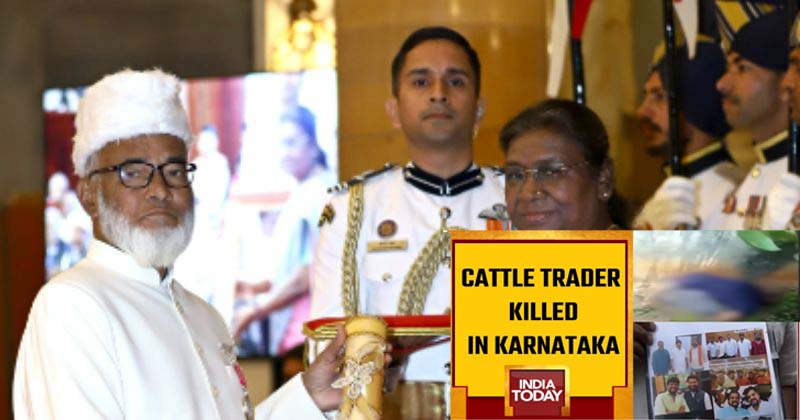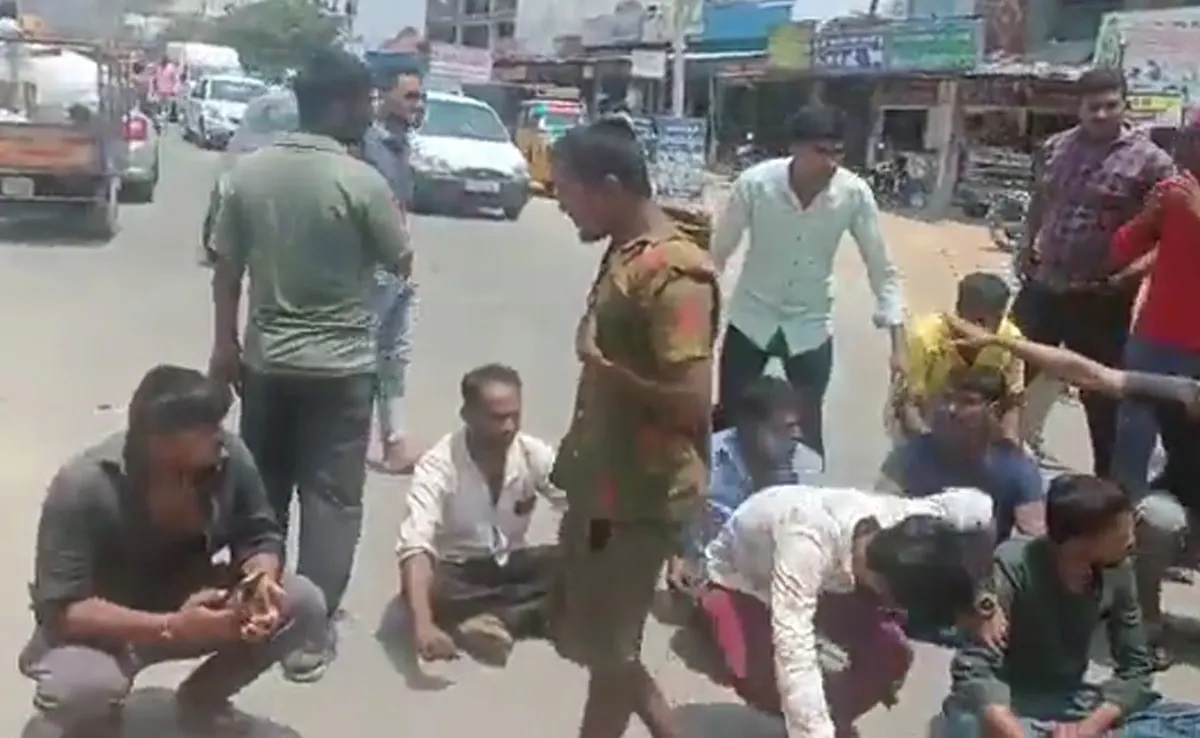
The blurred, bloodied and barely recognisable body of 38 year old Idrees Pasha sprung on to the country’s consciousness three days after his brute murder, lynch death committed by Hindutva serial hate offender Puneeth Kerehalli in the Sathanur police station area of Ramanagara district of Karnataka, on April 3, 2023.
Three days later, cameras zoomed in on another Muslim from the state, elderly Shah Rasheed Ahmed Quadri, an expert craftsman of the Bidri craft of northern Karnataka being awarded the Padma Shree. Rasheed, overwhelmed, said, on the occasion where luminaries of the union government and the Bharatiya Janata Party (BJP) were visible, that “he never expected prime minister, Modi to assent to the award to a Muslim craftsperson”, and that he was therefore proven wrong in his misconception. Modi laughed in response, reports said.
Why the connection? What is the irony behind the dual, contradictory imagery?
Karnataka goes to the polls for one. In just another month’s time. And along with Abdul Rasheed’s beaming gratitude, the ghastly death of Pasha, laced with the consistent calls for the socio-economic boycott of Muslims and their businesses in the state has coloured the electoral campaigning on the political landscape. Pasha’s gruesome death is not the only tale of minority lives lost to targeted gore.
The ruling Bharatiya Janata Party (BJP) that captured power after a money-induced tussle (read 2019 Operation Kamala!!) has left virtually no stone unturned to permit a grossly divisive politics in the public sphere in the state. Young Muslim women were denied education by targeting the ‘hijab’ (veil), a misguided section within the community making it worse by pushing for the recognition of the veil as an essential religious practice. Open calls for the boycott of businesses run by Muslims were allowed unchecked. And Tipu Sultan, that symbol of a resistance against British colonial rule, is selectively and culturally demonised. Not to mention the national level exclusions at the policy level, purging Indian history text-books selectively, of Gandhi’s assassins and the entire period of Mughal rule. A stony silence from the regime’s leadership marks these unrelenting “changes”. The political opposition, stuttering and hesitant when it comes to all issues related to representation, rights and secularism is muted in its criticism. Anything and all that is Muslim then, past, present (and future?) is sought to be erased. In the midst of this hate, a soppy palliative, the calming image of gifted Abdul Rasheed, the bidri master craftsman swirls around the airwaves.
The connections are not tenuous but obvious, between the hate offenders and the hate mongers. As The Wire has reported, Puneeth Karehalli, the leader of the March 31 lynch mob that killed Idrees Psha, is the president of a “far-right Hindutva outfit called Raastra Rakshana Pade (literally, ‘national security organisation’)”, which was involved in campaigns against halal food and demanding the expulsion of Muslim vendors from areas near Hindu temples. On his social media platforms, Kerehalli proudly shares several photos of him with prominent BJP leaders like Tejaswi Surya, Kapil Mishra, K. Annamalai, and C.T. Ravi. Both Surya, Mishra and CT Ravi are themselves aggressive hate mongers themselves. It is almost like a cruel re-play of the Stockholm Syndrome, a twisted psychological condition in which hostages, or victims develop a “bond” with the captors; a phenomenon that is supposed to result from abusive relationships built on power-imbalances. Throw in then, the additional spectre of a muted national and regional opposition –on these issues at least—that renders the offenders a false sense of invincibility.
A well-crafted eco-system then, this generation of targeted hate-letting that systematically spirals then from prejudiced attitudes, acts of prejudice, discrimination, violence and then, lo and behold, all out genocide. It encompasses the omnipresent Whatsapp factory, large sections of the electronic media, troll army on social media, non-state actors and speeches by elected officials in the public sphere, inaction by law enforcement and individuals and, finally we reach the peak: mass targeted acts of violence. All this sinister build-up, this hate-letting is and has been met with a stony unaccountable silence from the pinnacle of the pyramid, the most powerful among the regime’s leadership. Leaving it open for this section to play footsie with palliative tokenisms.

The Stick of Second Class Citizenship, the Carrot of the Award
So, as long as fear, servility and invisibility are accepted by the marginalised and “different”, some rewards are guaranteed. The vast community is slurred while stray individuals are handpicked. The aggression of the speech in the public sphere ensures a silence, self-restricted assertions of fair and equitable participation from the whole, so voices who, defiantly, do express this inalienable right, are dubbed shrill and sectarian.
That the blood and gore of the pre-dominant images of othering, the lynch mob, the murder of Muslims, the targeting (albeit differently) of Christians, the rendering of second class status through strident calls of boycott, are today sought to be calmed, placated by last Wednesday’s (April 5) image of a gratified Muslim master craftsman. Four days after this, on Easter Sunday, the big chief of the present regime, the prime minister, even made a customary and ritualistic visit to the Sacred Heart Church in the capital.
Does this imagery work? For a beleaguered and battered Muslim community splintered on class, caste and gender lines, some recognition, a slim sign of hope– even in the form of a gratuitous acknowledgement of nation building through craft– surely cannot be grudged. For the minute Christian minority that harbours its own problems and concerns, similar sops are welcomed. What moral or political right do the rest of India and Indians, especially silent witnesses to hate politics and hate killings –the vast majority—have, in expecting an exclusive resistance from the minorities?
As 2024 looms and state elections pepper the way, only expect more. More such dual stroke imagery where targeted loss is sought to be quietened by tokenisms of gratitude. A deeply fractured and divided Indian people will be selectively patted and pruned. While a seething mass of deprivation and disenchantment swirls. It is only the clarity of a united voice of resistance, based on principled recognition of allyships, between sections and the whole, of the marginalised and more that can resoundingly give an answer. To the cynical and overplayed politics of divide and rule.
Related:
Karnataka’s Shame: Cattle trader, a Muslim, beaten to death by cow vigilantes
Cow vigilantism continues with impunity in northern states of India
Under the guise of cow protection: reports of assault, illegal restraint against Muslims
Worsening Spiral of Communal Hate: State’s role in rising violence against minorities
The threat and lawlessness of “Gau-Rakshaks” in North India
Muslim truck driver allegedly attacked by cow vigilantes in Palwal, Haryana